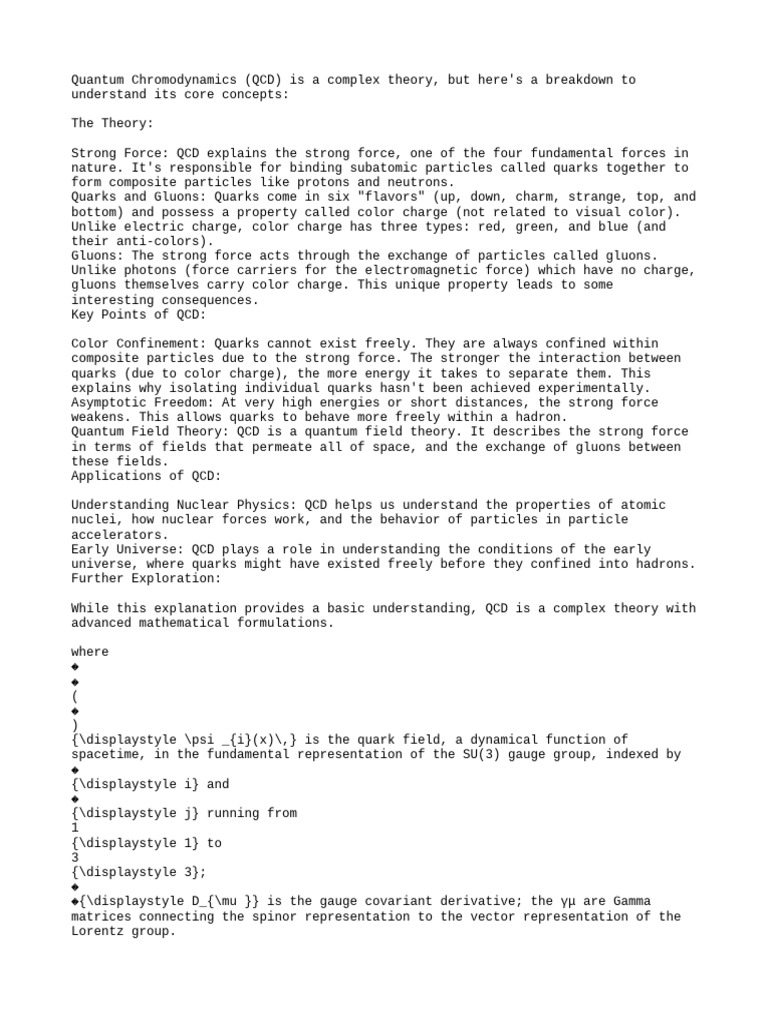Quantum Chromodynamics (QCD) stands as a pivotal theory within the realm of particle physics, elaborating on the intricate interactions that govern the behavior of quarks and gluons. It emerged from the quest to understand the strong force, one of the four fundamental forces of nature, which binds together atomic nuclei. This treatise explores the underpinnings of QCD, its foundational principles, and the implications it holds for our comprehension of the universe.
At its core, quantum chromodynamics is a quantum field theory that describes how quarks—the elemental particles that form protons and neutrons—interact via the exchange of gluons. Gluons are the force carriers that mediate the strong force, analogous to how photons serve this role for electromagnetic interactions. The term “chromodynamics” derives from the “color” charge of quarks and gluons, a property that anchors their interactions in a confounding yet fascinating tapestry of physical laws.
Within QCD, color charge is fundamental. Unlike electric charge, which can be either positive or negative, color charge exists in three types—commonly referred to as red, green, and blue. Quarks exhibit one of these charges, while gluons serve as the exchange particles that facilitate the interactions between quarks. This necessitates that all observable particles, such as protons and neutrons (collectively known as baryons), must manifest a neutral color charge, often described as a “colorless” state. The implication is profound: such color confinement prevents isolated quarks from ever being observed in nature.
One of the most profound predictions of QCD is confinement—the phenomenon wherein quarks are never found in isolation but rather in composite particles. For instance, protons and neutrons are each composed of three quarks, and their stability arises not merely from electromagnetic force but from the overwhelming strength of the strong force. This force becomes increasingly potent as quarks attempt to separate, leading to a requirement for additional quark-antiquark pairs to form, resulting in mesons or baryons instead of freed quarks. This intriguing characteristic fosters a deeper inquiry into the fundamental structure of matter.
As investigations into QCD progressed, the theory became fat with complexities and subtleties. The mathematical formulation of QCD is rooted in non-Abelian gauge symmetry, augmenting traditional quantum electrodynamics. This complexity gives rise to intricate interactions captured within the framework of perturbation theory, though such methods encounter limitations at low energies, where non-perturbative effects dominate. This necessitates alternative approaches, such as lattice QCD, where spacetime is discretized into a grid, allowing for computational analyses of non-perturbative phenomena.
The implications of QCD extend far beyond the confines of high-energy physics. One notable consequence is the phenomena of asymptotic freedom—whereby quarks behave almost like free particles within high-energy regimes, while at lower energies, their interaction becomes overwhelmingly strong. This counterintuitive behavior highlights the non-linear dynamics of QCD and poses significant questions about the transition from quark-gluon plasmas to conventional hadronic matter. Such states of matter are proposed to have existed in the early universe, signifying a crucial link anticipated for understanding cosmic evolution and the Big Bang.
As the theoretical frameworks of QCD continue to develop, experiments undertaken at accelerator facilities, such as the Large Hadron Collider (LHC) and the Relativistic Heavy Ion Collider (RHIC), probe the depths of these interactions. These high-energy experiments recreate conditions akin to those shortly after the Big Bang, permitting the study of quark-gluon plasma—a state where quarks and gluons are liberated from their confinements, allowing them to roam freely. The study of this exotic phase of matter not only elucidates the properties of the strong force but also reverberates through cosmological models, shedding light on the dynamics governing energy and matter in the universe.
Moreover, QCD’s principles find their echo in the realm of high-energy astrophysics, where the interplay of fundamental forces sculpts the cosmos. Consider massive astrophysical entities, such as neutron stars, where the force of gravity competes with the strong force. The tension between these forces often defines the structure of such stars, presenting an arena in which QCD principles may manifest under extreme conditions. The quest to ascertain the properties of matter at such densities not only benefits from QCD but also stirs curiosity about the broader implications for nuclear physics and cosmology.
The intricacies of quantum chromodynamics invite a holistic reevaluation of our understanding of matter and the strong force. Within its framework, researchers strive to unravel the enigmatic properties of confinement, asymptotic freedom, and the behavior of matter under extreme conditions. As this field continues to burgeon, offering new insights and predictions, it holds within its grasp the potential to revolutionize our comprehension of the universe, portraying a reality rife with complexities and profound interconnections.
In summation, quantum chromodynamics is not merely a theoretical construct; it is a luminous beacon illuminating the path toward a deeper understanding of the universe’s composition. As physicists venture into the frontline of QCD research, they are poised at a transformative junction where fundamental inquiries can lead to pivotal discoveries, reshaping our conception of reality itself. This journey through the realm of quarks and gluons promises not only to elucidate the microcosmic structures of matter but also to evoke a sense of wonder about the highly intricate and harmonious language of the cosmos.












